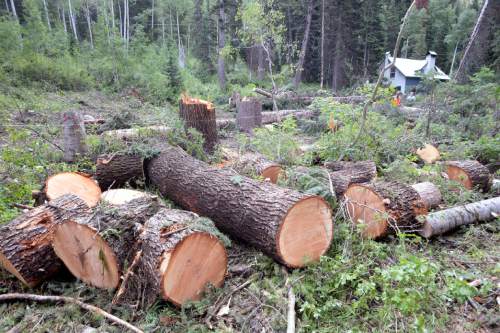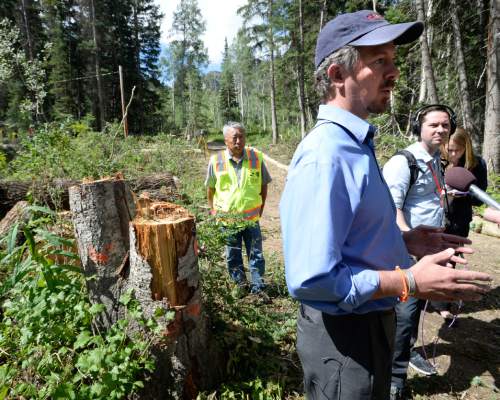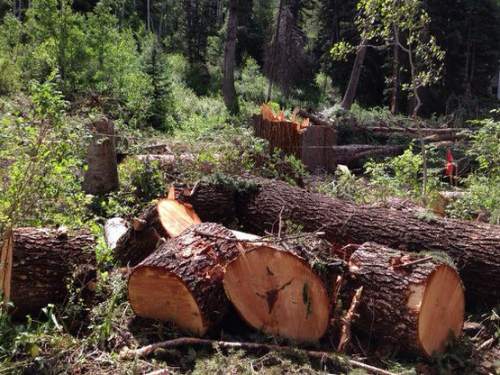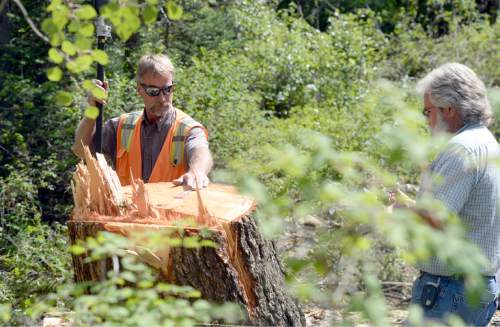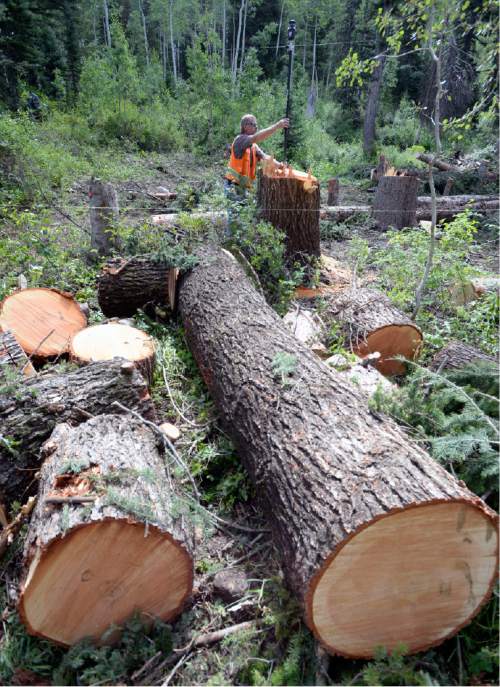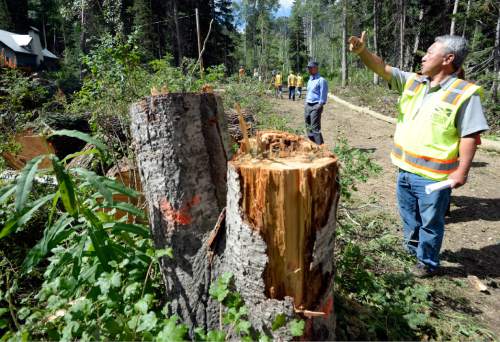This is an archived article that was published on sltrib.com in 2015, and information in the article may be outdated. It is provided only for personal research purposes and may not be reprinted.
State and federal criminal investigations are underway into the destruction of nearly 100 trees at an unauthorized housing development in an environmentally-sensitive tract of Big Cottonwood Canyon.
Forest rangers working on behalf of both Salt Lake County and the U.S. Forest Service are trying to determine how a tree-removal crew came to cut down more than 60 trees on the proposed Silver Hill subdivision in Silver Fork in July, and then went on to fell more than a dozen on a neighbor's property and 17 in the adjacent national forest.
Some of the trees appear to have been more than 200 years old, county officials said. Planning officials contend all the trees were illegally destroyed.
"Everything is on the table," said Salt Lake County District Attorney Sim Gill, who is also considering civil penalties.
The owner of Silver Hill is Craig P. Burton, a developer in the controversial Mount Holly luxury golf and ski club near Beaver, which had ties to convicted businessman Marc Sessions Jenson and a bribery scandal involving two former Utah attorneys general.
A tally finalized in early August by county planners shows 99 trees with trunk diameters of at least 2 inches were felled. Some stumps measured at least 3 feet across.
But counting the trees is only the first step to calculating the damage, said U.S. Forest Service spokeswoman Loyal Clark.
When sensitive ecosystems lose their largest, oldest living things, the effects may be far-reaching. Forestry specialists are working alongside rangers to find out "what that means to the watershed, the health of the forest, the landscape," Clark said. "How has it impacted, and will it impact, the area up there?"
The analysis could take weeks, Clark said. She said it is too early to speculate whether federal charges may be pursued in connection with the trees felled in the Uinta-Wasatch-Cache National Forest where it abuts the Silver Hill site.
It also isn't clear who faces more potential criminal liability: the developer or the tree removal crew hired for the job.
—
'They were totally aware' • Silver Hill's project engineer, Scott Carlson, has said the developer walked the crew through the area and warned against cutting trees on neighboring land. Carlson has declined to identify the crew for either The Salt Lake Tribune or county officials, but has said the company did not follow instructions.
The county contends Silver Hill should not have brought a crew into the area because the developer did not have approval to begin work.
The county Planning Commission put more than 30 conditions on a preliminary subdivision plat it approved in May, and the final plat hadn't been approved, said Rolen Yoshinaga, planning and development services director for Salt Lake County Township Services.
Under a county ordinance that governs development in the Wasatch canyons and foothills, building or grading permits are required for tree or vegetation removal. But Silver Hill's application for a grading permit was sent back because it did not specify the boundaries of the construction work or how storm water runoff would be prevented, Yoshinaga said.
Carlson said he considers tree removal to be separate from the grading permit and the pending plat approval. He argued that Silver Hill conveyed its plans to the county, having submitted a tree inventory and utility corridor plans.
But county records obtained by the Tribune suggest planning officials were not aware of specific trees to be removed.
A tree survey filed by Silver Hill appears to map all of the trees on the parcel and potential sites for replacement trees, but indicates none for removal. A grading diagram was stamped by the county on June 16 for approval, but includes a directive that "natural vegetation shall not be removed without approval from Salt Lake County Township Services."
And the county's preliminary plat approval letter to Carlson, dated July 10, states: "Current plans do not call for the specific removal of any trees. If any significant trees … are removed from the site, replacement trees will be required."
Carlson characterized the note as a misstatement.
"They were totally aware of trees to be removed," he said. "We had lots of discussions about trees and replacement of tees, and what kinds of trees and size of trees."
Yoshinaga said zoning ordinances require the county to finalize construction boundaries, taking into account individual trees. In this case, permission was not a foregone conclusion, Yoshinaga said.
"I'm not sure they all would have come out," he said. "A 40-inch tree is going to raise some eyebrows."
—
Setting boundaries • Under rules well-known to builders, the boundaries of construction work must be marked with fencing, which inspectors typically examine before work begins, said Max Johnson, planning supervisor for Township Services.
Fencing should surround individual trees to be protected, as well as the project limits — "so something like this doesn't happen," Johnson said.
Carlson, who said he has engineered dozens of projects in the Wasatch canyons, disputed that. "It's not a requirement, it's an option," he said. "There's all kinds of ways to identify what needs to happen."
But alternatives to fencing must be approved, the ordinance says, and Yoshinaga said Silver Hill did not make such a request.
County officials also have said that Silver Hill did not install erosion protections to prevent runoff into Big Cottonwood Creek — the most immediate hazard of forest destruction. Had Silver Hill obtained a permit, the process would have required the developer to place barriers and build diversions before cutting began, Yoshinga said.
Carlson has said the danger of erosion is caused by stump removal, which Silver Hill has not yet begun.
But with frequent summer storms pelting the now-exposed ground, Yoshinaga said the damage is done. "You can't remove tree cover without affecting what's on the ground."
The county has ordered work stopped at the site, but planners don't know what the project's future will be.
None of the fines associated with permit violations is more than $1,000 per day, Yoshinaga said. Gill says he has not yet established which, if any, are applicable.
Gill acknowledged the county could struggle to enforce regulations if developers view penalties as an acceptable cost of doing business, but he said it was "premature" to say whether the county might withhold a permit for Silver Hill.
"What's important to communicate is that we're really taking this seriously," Gill said. "This is a concern to our clients [the county] as well as to our community." —
Silver Hill owner had ties to failed Mount Holly resort
Silver Hill owner Craig P. Burton, a Murray developer, was a key player in the proposed Mount Holly resort, a failed golf and ski development near Beaver. His company, CPB Development, held a 5 percent share in the project and worked to acquire land and meet Beaver County regulations.
Several locals had objected to the plan to convert the sleepy Elk Meadows ski area into an exclusive resort, arguing it would restrict access to popular slopes and strain public services and water supplies. The project went bankrupt and a referendum sought by opponents never occurred.
In 2006, the U.S. Forest Service challenged Burton's Wall Street Journal ad that claimed the resort could run ski lifts and snow cats up Mount Holly. The peak is on national forest land where motorized equipment is restricted. The ad also promoted skiing within the year, even though the development had not been approved. Burton dropped the claims from his website.
In January, Mount Holly promoter Marc Sessions Jenson was acquitted of fraud charges stemming from allegations that he failed to tell investors the development was near bankruptcy and faced multiple lawsuits, or that he had past fraud convictions.
The case has ties to the bribery scandal that has ensnared former Utah attorneys general John Swallow and Mark Shurtleff, who prosecuted Jenson in 2008 and 2011. Jenson has said he was charged as political payback after refusing to cave to a "shakedown" by Shurtleff and Swallow, who he claims pressed him for money and favors.


